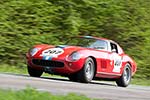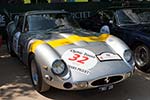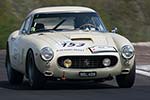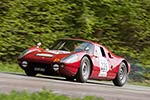
There were no purpose built race tracks during the dawn of motoring so all races were held on public roads. The most common were events between two cities but there were also longer races like the Tour de France (Automobile), which was first organized in 1899. As the name suggests the event was basically a round-trip of France, much like the bike race of the same name that was first held a few years later. The Tour de France was held off and on until 1986. The interest in the event peaked during the 1950s and early 1960s. At that time it even was one of the World Manufacturer Championship rounds. Financial problems and concerns over safety saw the Tour de France cancelled after the 50th edition in 1986.
Six years later, the Tour de France Automobile (later renamed Tour Auto) returned as an historic event. Representing the original race's heyday, the Tour Auto is open to cars of a type that competed in the Tour de France between 1951 and 1973 as well as later cars of special interest. Since then well over 200 cars have lined up every year for the five-day marathon through France. The field is split in three competition and two regularity classes. The entrants in the competition class need to set the fastest possible times, while in the regularity class consistency is key. Eligible for overall victory are cars of up to 1966 (the 'VHC' class), which represents the final time the original Tour de France Automobile was held as an important international event.

Although the route changes every year, the Tour Auto traditionally starts in Paris and finishes somewhere in the south either on the Mediterranean or Atlantic coast. This year the itinerary was fundamentally different. With the first stage heading from Paris to Beaune, it did start off in a southern direction. However, the subsequent days the cars headed north with stops in Mulhouse, Luxembourg and Marcq en Barceuil, eventually finishing in Deauville on the Atlantic coast. It was the first time to our knowledge that the Tour Auto visited Belgium and Luxembourg. As always the organization managed to find some amazing back-roads that really underline just how beautiful the country is.
Another major revision this year was the start location. Traditionally the cars gathered on the Trocadero square on the other side of the Seine river from the Eiffel Tower. However due to a lack of space, the start location moved to the Grand Palais, the longtime host of the Paris Auto Show, some years ago. It was however not available this time, forcing the organizers to find yet another suitable location. They did so in great style picking the Tuileries Gardens, positioned between the Louvre museum and the 'Place de la Concorde.' Very early on the first day the cars left the park for the nearby Monthlery track where the official start took place with a timed stage.

While most of the Tour Auto is run on public roads, each day features two timed stages on closed roads and a visit to a race track. Much like in a rally, the closed road stages have to be completed in one try following pace notes available in the road book. At the track the drivers get a practice session to get a good grid position. The 'race' itself is also a timed session with the clock only starting once the car crosses the start/finish line. All the times and penalties combined create the standings in the competition class. As mentioned earlier, regularity is all about consistency. The drivers have to complete the stages with a predefined average speed. This enables classic cars of all types to fight for victory.
Taking center stage in this year's edition of the Tour Auto were the Jaguar Mk I and Mk II, celebrating the Mk I's 1959 class win. The Mk I and Mk II won the class four more times. By far the most successful campaigner of these machines was Frenchman Bernard Consten. He has been the traditional opening driver of the rally and this time headed field in a Jaguar Mk II. He was closely followed by organizer Patrick Peter, who piloted the Jaguar Mk II originally raced by Jack Sears in the 1962 edition of the Tour de France. Taking part in the event were a further five Mk I/IIs, including the Mk I that Consten drove to a class win in 1963.

As mentioned earlier, Ferraris dominated the event in the 1950s and early 1960s. Most successful of all was the 250 GT model of which the competition version quickly earned the 'Tour de France' nickname. Surprisingly not one 250 GT 'TdF' lined up this year. There were nevertheless plenty of Ferraris assembled, highlighted by the 250 GTO that won the 1964 Tour de France outright. That was the final year, the event was part of the World Championship. The bulk of the Ferrari field was however formed by the later 275 GTB. A vast majority of these were road cars, except for the 275 GTB 'Competizione' fielded by Stephen Read and the 275 GTB/C entered by Arnold Meier. Especially Read's 275 created a glorious howl that could be heard from miles away.
For the first time in some years mid-engined sports racers like the Ford GT40, Ferrari 250 LM and Porsche 904 were once again admitted to the VHC class and were thus in contention for the outright victory. That was clearly reflected in the final results, which saw Shaun Lynn in his GT40 take the win ahead of the AC Shelby Cobra that won last year and another GT40. The winner of the more modern class was 'Mr John of B' in his all-white Porsche 906. The husband and wife team of James and Fiona Willis took top honors in the Regularity class in their MGA. Marco Cajani clinched the Index of Performance award in his modest but very loud Alfa Romeo 1900 TI.

The competition element is of course important but for most participants taking part itself is enough of a reward. The Tour Auto offers them a rare opportunity to enjoy their cars on some of the finest and most beautiful roads as well as the finest race tracks in the world. The lunch and finish locations are also carefully selected. Some of them provided interesting surprises like the finish in Beaune, which looked like a small castle of which there are many in France. However around the corner we discovered an impressive collection of dozens jet fighter planes from the 1950s and '60s.
Unfortunately we could not follow the Tour Auto for two days due to conflicting schedules with the Concorso d'Eleganza Villa d'Este. We nevertheless greatly enjoyed ourselves on, and next to the route. Following or partaking in the Tour Auto should really be high on any enthusiast's list. The reason why can be found in our exclusive
150-shot slideshow filled with action from the public roads and also from the swooping Dijon track. Next year we will try to complete the full five days to give you an even better picture of the great road race.

 There were no purpose built race tracks during the dawn of motoring so all races were held on public roads. The most common were events between two cities but there were also longer races like the Tour de France (Automobile), which was first organized in 1899. As the name suggests the event was basically a round-trip of France, much like the bike race of the same name that was first held a few years later. The Tour de France was held off and on until 1986. The interest in the event peaked during the 1950s and early 1960s. At that time it even was one of the World Manufacturer Championship rounds. Financial problems and concerns over safety saw the Tour de France cancelled after the 50th edition in 1986.
There were no purpose built race tracks during the dawn of motoring so all races were held on public roads. The most common were events between two cities but there were also longer races like the Tour de France (Automobile), which was first organized in 1899. As the name suggests the event was basically a round-trip of France, much like the bike race of the same name that was first held a few years later. The Tour de France was held off and on until 1986. The interest in the event peaked during the 1950s and early 1960s. At that time it even was one of the World Manufacturer Championship rounds. Financial problems and concerns over safety saw the Tour de France cancelled after the 50th edition in 1986. Although the route changes every year, the Tour Auto traditionally starts in Paris and finishes somewhere in the south either on the Mediterranean or Atlantic coast. This year the itinerary was fundamentally different. With the first stage heading from Paris to Beaune, it did start off in a southern direction. However, the subsequent days the cars headed north with stops in Mulhouse, Luxembourg and Marcq en Barceuil, eventually finishing in Deauville on the Atlantic coast. It was the first time to our knowledge that the Tour Auto visited Belgium and Luxembourg. As always the organization managed to find some amazing back-roads that really underline just how beautiful the country is.
Although the route changes every year, the Tour Auto traditionally starts in Paris and finishes somewhere in the south either on the Mediterranean or Atlantic coast. This year the itinerary was fundamentally different. With the first stage heading from Paris to Beaune, it did start off in a southern direction. However, the subsequent days the cars headed north with stops in Mulhouse, Luxembourg and Marcq en Barceuil, eventually finishing in Deauville on the Atlantic coast. It was the first time to our knowledge that the Tour Auto visited Belgium and Luxembourg. As always the organization managed to find some amazing back-roads that really underline just how beautiful the country is. While most of the Tour Auto is run on public roads, each day features two timed stages on closed roads and a visit to a race track. Much like in a rally, the closed road stages have to be completed in one try following pace notes available in the road book. At the track the drivers get a practice session to get a good grid position. The 'race' itself is also a timed session with the clock only starting once the car crosses the start/finish line. All the times and penalties combined create the standings in the competition class. As mentioned earlier, regularity is all about consistency. The drivers have to complete the stages with a predefined average speed. This enables classic cars of all types to fight for victory.
While most of the Tour Auto is run on public roads, each day features two timed stages on closed roads and a visit to a race track. Much like in a rally, the closed road stages have to be completed in one try following pace notes available in the road book. At the track the drivers get a practice session to get a good grid position. The 'race' itself is also a timed session with the clock only starting once the car crosses the start/finish line. All the times and penalties combined create the standings in the competition class. As mentioned earlier, regularity is all about consistency. The drivers have to complete the stages with a predefined average speed. This enables classic cars of all types to fight for victory. As mentioned earlier, Ferraris dominated the event in the 1950s and early 1960s. Most successful of all was the 250 GT model of which the competition version quickly earned the 'Tour de France' nickname. Surprisingly not one 250 GT 'TdF' lined up this year. There were nevertheless plenty of Ferraris assembled, highlighted by the 250 GTO that won the 1964 Tour de France outright. That was the final year, the event was part of the World Championship. The bulk of the Ferrari field was however formed by the later 275 GTB. A vast majority of these were road cars, except for the 275 GTB 'Competizione' fielded by Stephen Read and the 275 GTB/C entered by Arnold Meier. Especially Read's 275 created a glorious howl that could be heard from miles away.
As mentioned earlier, Ferraris dominated the event in the 1950s and early 1960s. Most successful of all was the 250 GT model of which the competition version quickly earned the 'Tour de France' nickname. Surprisingly not one 250 GT 'TdF' lined up this year. There were nevertheless plenty of Ferraris assembled, highlighted by the 250 GTO that won the 1964 Tour de France outright. That was the final year, the event was part of the World Championship. The bulk of the Ferrari field was however formed by the later 275 GTB. A vast majority of these were road cars, except for the 275 GTB 'Competizione' fielded by Stephen Read and the 275 GTB/C entered by Arnold Meier. Especially Read's 275 created a glorious howl that could be heard from miles away. The competition element is of course important but for most participants taking part itself is enough of a reward. The Tour Auto offers them a rare opportunity to enjoy their cars on some of the finest and most beautiful roads as well as the finest race tracks in the world. The lunch and finish locations are also carefully selected. Some of them provided interesting surprises like the finish in Beaune, which looked like a small castle of which there are many in France. However around the corner we discovered an impressive collection of dozens jet fighter planes from the 1950s and '60s.
The competition element is of course important but for most participants taking part itself is enough of a reward. The Tour Auto offers them a rare opportunity to enjoy their cars on some of the finest and most beautiful roads as well as the finest race tracks in the world. The lunch and finish locations are also carefully selected. Some of them provided interesting surprises like the finish in Beaune, which looked like a small castle of which there are many in France. However around the corner we discovered an impressive collection of dozens jet fighter planes from the 1950s and '60s.







